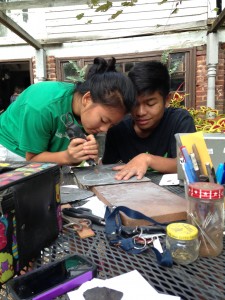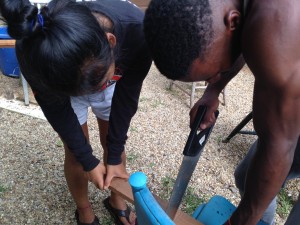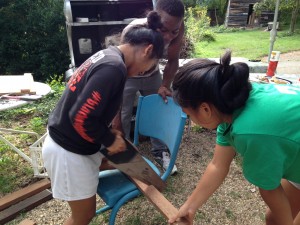When my brain is too full of words to process, I must resort to pictures. This week has been so amazingly full, inspiring and life-affirming, I haven’t even been able to begin filing it appropriately. Enjoy these pictures of so many amazing people!
Category Archives: Access
Motivation: It’s a continuum, not a dichotomy
I remember happily nodding along with the platitudes about intrinsic and extrinsic motivations during grad school. The information fit within my ideals about learning for learning’s sake. Intrinsic motivation– the motivation to learn and perform for a feeling of internal satisfaction– was in my mind the golden standard. Rewarding students, a form of extrinsic motivation, was detrimental to the health of the learner, would sap their love of learning, and would create generations of lab rat-like students performing their tasks for a stipend of sugar-laden M&Ms.
After all these years, my understanding of intrinsic and extrinsic motivation is quite different, Continue reading
College Essay, How I Love Thee
Ugh, college essay time! Right? Wrong. I love the process of writing the college essay. The college essay serves lots of purposes. It can explain away a period of poor grades. It can personalize all the numbers. It can provide context for afterschool activities. Most importantly, though, it is the student’s story, as told by and understood by the student.
Writing a college essay can allow students to see themselves differently, to recast their stories, to gain confidence and to feel entitled (in the best way) for the educational opportunities they are pursuing. Grade school has become such a disparate series of parts, that it can be hard for a young student to understand the process and his or her role in it. Oftentimes, the students I work with have experienced some sort of failure or aren’t as competitive as their peers. The college essay allows them to explain the circumstances, and to highlight how they excelled even in the face of adversity.
What’s a string of Bs and Cs in general level classes in the face of the struggles I see? The stories of students I work with are complex, and sometimes heartbreaking. A 20 year-old mother who was impregnated by rape at 13, and is raising the baby, alone, and in a foreign country. A daughter who cried as her father was dragged out of their home and shot dead. A boy who has been responsible for paying for his school supplies and clothes since he was 13 because his family needs any available money for food. A young woman who is the product of generations of rape. A young man who fled his home place because his father was kidnapped and held for ransom. You could meet these students 100 times and never know these things about them because they present as strong, and resilient. And they are strong and resilient, or they wouldn’t have survived.
But their grades are so-so, or their SAT scores are just average, or they haven’t done enough extra-curricular activities to be competitive. The college essay can contextualize that so-so high school performance and demonstrate that that performance, given the pressures, the obstacles, the hardships that were faced, was in fact exemplary, and outstanding, and that young person asking for more education and more opportunity would be an asset to the college.
When young people write their own stories, through the process of the college essay, they can see themselves as worthy, as hard-working, as heroes of their own stories. In turn, they enter a new part of their lives having a sense of their journey knowing that they have already overcome so much, and the challenges of succeeding in school are not insurmountable.
Transitioning Youth to College
I love working with teens and young adults. They are outwardly brave and bold, but secretly vulnerable, still seeking approval and reassurance. They want to be independent and make their own decisions, but they also want to establish themselves on the paths to responsible adulthood.
I tend to work with young people who have circumstances that are different than my own, and maybe yours, at the same age. They are people of color. Or they are young parents. Or they are first generation college students. Or they immigrated to this country. Or they speak another language at home. Or they live below the poverty line. Or they practice a non-Christian religion. Sometimes the students I work with are described as “minorities”, “at-risk”, “low-SES”, “underserved”, “low-income”, “disadvantaged”, “low-achieving”, “under-performing” or any other term that sounds good in a grant application.
I hate using these terms, because it’s othering. These terms make these kids sound “needy”. All 16-22 year olds are needy. They need fully-grown adults to guide them, even when they are jerks, make dumb choices, and say they don’t want help. Conservative pundits talk about people pulling themselves up by the bootstraps, while their own challenging kids attend private schools, experience prestigious unpaid internships and are tutored in every subject.
Teenagers who grow up in homes of privilege, homes where the status quo is to go to college and get a professional job, are exposed to important support, knowledge and experiences that may not available to teenagers who are first generation college students. For example:
- The expectation that they will go to college AND graduate from college,
- The connection between difficulty of classes, GPA and SAT scores on college selection and acceptance,
- Familiarity with college campuses (including visits to alma maters of family members)
- Understanding implications of financial aid such as loans, scholarships, grants, etc,
- Differentiating between for-profit vs traditional colleges,
- Awareness of and importance of a major,
- Knowledge of connection between major, graduate school, certification and ultimate job opportunities,
- Familiarity with college support systems such as career counseling and job placement rates,
- Awareness of the admissions, financial aid, and add/drop deadlines and that the onus is on the student, not the school.
Which of these did you implicitly know? Sure, maybe like me you regretted a few choices but also maybe like me, you had access to and the resources for the following opportunities (privileges):
- Sufficient reading, writing and thinking skills to be immediately successful in college
- A “Gap Year”
- Travel
- Extracurricular classes and Camps
- A home base to return to
- A car
- An allowance or parental loans
- A support person to nag you onto track
- A quiet place to apply to college
- A strong network of entrepreneurs and business owners (I can name at least 5 jobs that I had before the age of 22 that I got because of my network of family and friends)
- Enough financial security to delay entry into the workforce through undergrad and grad school
- The same skin color and cultural background as the majority of business owners and patrons in the lucrative downtown mall district
There are many programs that are doing a lot to help students transition successfully to college: Upward Bound and AVID are two Charlottesville programs that do a great deal to help students, but we can do more. We need to do more.
Building Experiences
As I transitioned out of my role as Program Director at Computers4Kids, I wanted to make sure that I didn’t lose contact with a number of students who I had formed especially close relationships. I had a group of them out to my house on Sunday to “build stuff” as they requested. I provided ingredients for lunch, computers for looking up plans, lumber and simple building tools. Fatuma, college freshman, was our documentarian. Her words and pictures are below.

Fatuma was trying to make this small beautiful doll house, but it kinda didn’t work out, so instead she is making a bird house. 🙂

July is looking for bird house design on the web! P.S. the bird house she made was amazing! The little birds will love it!

Fatuma trying to get started with her beautiful bird house. There were times when she really wanted to give up but Miss Dolly kept on motivating her! 🙂

Miss Dolly helping July with her bird house plan! If it wasn’t for Miss Dolly, nothing would have gone right! Thanks Miss Dolly, we love you!

Now this is what I call a amazing teamwork! July helping Zarny with the dremel tool to help it carve better!

Zarny slicing the chicken apart! P.S. he sliced it first and than he asked if he should all cut the chicken into pieces! lol!
Care and Maintenance of Gadgets in the Wild
We sometimes act as though our shiny gadgets are thoroughly reliable constants. By simply living outside of the norm, I constantly expose my computer equipment to difficult circumstances. As a friend said “Your gadgets are tested more than any tool since Deliverance.” Paddle faster?
A few ridiculous equipment circumstances from my own life:
- My iMac regularly develops a film of condensed water that blurs half of my screen, making HD or retina display options seem completely optional. Do they make Rain-X for computers?
- An inch and a half long hornet somehow committed suicide in the backside of my eMac. The hornet was much larger than any vent, so it was a mystery how it gained entrance.
- A mud dauber (another wasp-like flying insect) plugged the headphone jack on my iPad with mud while attempting to build a hatchery for its young.
Living in humid Virginia in a log cabin is at times difficult on the body… but it’s hell on my gadgets. There are other challenges as we move further outside Western suburbia. When traveling to Ghana last year I carried a used laptop as a gift to my host. While she had some correct electrical adapters, she didn’t have a sufficient surge protector. The power cable overheated, burning out the power adaptor and rendering the laptop temporarily unusable. Thankfully as I traveled with the laptop I didn’t run into the problem that my friend had with another laptop in Israel. A Palestinian friend had passed along a laptop in hopes that she would be able to repair it. The Israeli border patrol stopped her and wanted to know why she was traveling with a non-working laptop with a non-US power supply. She was questioned for quite a long time while they ensured that she was not ferrying an explosive device.
It’s easy to think that we can ship extra computers to the underserved corners of the world and fix access problems. It’s not that simple. Any computer, including mine, not housed in a tightly-sealed, climate and environment-controlled building, is at the mercy of insects, humidity, dust, heat and a myriad of other concerns. Electrical surges and differing currents wreak havoc. Security at schools continue to be an issue; computer labs set up previous years by other visitors were robbed. Even when all these hurdles are surmounted, basic maintenance remains a problem. Older computers are likely to have hardware malfunctions and updating software through dial-up Internet connections is challenging.
It’s critical, and inevitable, that computers will continue to penetrate to all parts of our globe, but it’s likely that we’ll bypass many of the challenges that desktop models give us and instead replace it with mobile and cellular technologies. As the world moves to mobile, it’s hopeful that we’ll have more durable gadgets with fewer environmental and maintenance issues.
Unplug the Games: The value of human to human play
This summer we’re teaching a series of optional free camps at Computers4Kids. The goal is to provide a fun and engaging experience, but also introduce concepts that might pique the students’ interest. Last week I observed a phenomena that I had noticed before — a definite lack in students’ problem-solving skills. This wasn’t in an unfamiliar content area, but a simple game of 20 questions where the items were familiar animals, foods and objects. It was hard to watch the student stymied by the task. He wasn’t able to construct questions, even with prompts, that would lead to him guessing his hidden animal. He seemed frustrated and embarrassed, but other students lent him support and he was able to succeed eventually. This game that seemed so familiar to me and most of the students was clearly foreign to him.
Observing this interchange made me think about how important games are to children’s development of problem-solving and critical thinking skills. How many hours of my childhood journeys were occupied with searching for objects that started with certain letters or fit into different categories, guessing a word, or out-spelling the driver? Thinking about strategy, getting tricky, and being clever were all skills that offered gratification and reward. Successful thinking was play and fun. It was valued.
Certainly many of these experiences can be duplicated on smartphones. There are plenty of free or cheap apps with guessing games built in, some lacking a few key components:
- An authentic feedback loop. It’s more gratifying to hear a peer or adult congratulate you for fresh thinking or more efficient guessing than canned computer feedback, no matter how intelligent the system is.
- Evolution of gameplay. When you’ve planned the same game mile after mile, you begin to shift the rules and boundaries to keep the gameplay challenging and new. The negotiation of the rules to keep play fun, challenging, or to make it appropriate for different levels of players is a critical skill for young players.
- Reading the opponent. When people play games against one another, they observe the strengths and weaknesses of the other’s play. Predicting a player’s next steps is often crucial in competitive games. Being able to parse the psychology of a colleague is a valued skilled in real life.
- Spontaneity. Humans almost always bring a sense of unpredictability to gameplay. While a computer algorithm can be analyzed and predicted, humans tend to ignore logical steps and respond “irrationally”; sometimes a perceived “losing” move is a strategically savvy one. Many computer programs aren’t equipped to play the long game.
Certainly I don’t disdain computer games and apps completely. I can’t stop playing a Tetris clone on my phone, but I see that games still need to come out of the digital sphere and into our human one. Sitting in the backseat affixed to the smartphone is no substitute for playing a game of I Spy out the window. Just because an activity is lo-fi, doesn’t mean that it’s not valuable.
Prepping for the DML Badges competition…
In 2 days I’ll be flying out to California in compete in the Digital Media + Learning Badges Competition. There I’ll be presenting Computers4Kids’ Teen Tech program. I’m super proud to be heading out to this pretty elite competition; the MacArthur Foundation funds and Mozilla sponsors. Computers4Kids is definitely one of the smaller organizations that will be competing, but I’m feeling pretty confident about my ability to make a winning argument.
We’ve been working hard for the past few years at C4K to align what the kids are doing to national standards. I think this sets apart from a lot of other non-profits. And while it’s personally and professionally gratifying, what keeps me grounded and directed is that everything we’re doing leads to further student success. It’s easy to get caught up in the idea that all this leads to agency success: recognition=more money=greater sustainability, but it’s hard for me to maintain excitement about that.
The realization I had the other day is that by aligning what students learn and practice to recognizable and recognized educational outcomes, we can better communicate to them, schools and employers how valuable their skills are. For under-served students in particular, having that self-esteem and self-worth is crucial. I want to arm myself with the knowledge that C4K is making a real difference in youth’s lives and that curricular alignment and larger efforts like badging systems contributes in a significant way.
On Winning
“Education” and “competition” are not usually words that are associated with each other. However, competition is an innate motivator, and humans by nature enjoy winning.
Certain aspects of winning are universal to all competitive activities, including learning. A recent Newsweek article about winning provides insight into how instructional designers can create more engaging training. The author notes that winning by itself is not the most compelling impetus, but that winning while a competitor loses is more satisfying (this would seem obvious to anyone with siblings).
Rather than using a “task completion” metaphor, instructional designers should use a gaming and winning metaphor when designing training. Rote tasks can be made more engaging if instead of simply reading and reacting in a safe environment, the learner triumphs over a tension-filled activity. Similarly, you can provide competitive opportunities with other learners virtually.
In many K-12 situations “safe” learning environments take out so much of the excitement of competition and rating. You have an obligation to make sure every beginner learner succeeds, but you also have an obligation to groom the special talents that individuals have as well.
How do you turn cognitive tasks into challenge?
Learning objectives can remain the same, but it’s the way that it is presented that changes. You don’t have to completely redesign your training to make it more challenging. Consider these simple ideas:
Allow learners to be wrong
- Allow and penalize for incorrect answers. If learners can complete a course by merely clicking through content, they have little reason to engage with the content. Activities that allow for “failure” can create “good tension”.
Add variable scoring
- Reward learners for learning more difficult material by acknowledging that all content is not equal.
Add timed components for some activities
- While not appropriate for all activities, it does create a feeling of tension.
Allow for replay opportunities
- This reduces some of the negative aspects of the capability for “failure” allowed by other competitive components.
Create opportunities to share leaderboard scores outside of the learning environment
- Rather than learning taking place within a silo, authentic learning events can bleed into the larger community.
A simple multiple choice game can be either boring or competitive with a simple design tweak:
Boring
- The learner answers a question and then views the answers tagged with “correct” and “incorrect” feedback.
Competitive
- The learner answers a question. They receive variable points based upon the correctness of the answer, difficulty of the challenge and the speed with which they answered. They are then shown their score relative to other learners. The feedback is also contextual and continues the gameplay.
Take some lessons from this short quiz. How many times did you feel compelled to play?
A version of this post appeared on The Total Learner Experience.
Microsoft’s Digital Literacy Curriculum Sucks. Surprised?
I originally posted this in May of 2009.
I work as a program director for a non-profit devoted to mentoring and tech literacy in low income 7-12 graders. As such, I am often looking for useful curriculum related to a wide variety of programs, tasks and skills. I am often in debate with myself and others if it is better to provide the students with practical skills related to secretarial-type work or to explore the outer boundaries with projects in graphics, animation and web design. Our approach is to focus on allowing students to explore and produce with the more creative software while providing auxiliary work with students who see the value of learning the more practical Office suite.
Not wishing to reinvent the wheel, I regularly look for clear, self-directed lessons suited for my students. Oh, and free or cheap, because we’re a non-profit. I’ve looked at Microsoft’s Digital Literacy Curriculum several times to see if we can use it to demonstrate proficiency. Now I can hear some of my techie friends slapping themselves in the head, about to eviscerate me because I even mention the Evil Empire. Let me introduce you to the real world outside of your basement and Silicon Valley. Most people out here in the light, don’t care or know about Open Source. They are just grateful that they can reliably turn on their computer and spit out some information. Their focus is on their work, not arguing about the benefits of Ubuntu versus Morphix.
Back to the Digital Literacy Curriculum, it sucks. No surprise there, it is a Microsoft product. Now I know I am late to the bandwagon, but I’ve still got to pile on. Everything about Microsoft sucks. I am a native proud Mac user, but practicality has required me to have a fairly good working knowledge of the Windows world. I work with Microsoft as a recipient of donated software and OSs as part of our non-profit work. Each month when I need to report our usage I curse in my head. It’s almost as though they take pride in having an interface that is clunky and unusable. For a company that’s flush with capital they sure are stingy with any ease of use or follow through to their systems. The Digital Literacy Curriculum reflects this attitude. It’s almost as though Microsoft is full of idea-men with no one to come back to ensure quality control. hmmmm….
I’ve looked at it before at work, but I wanted to give it a more detailed fish eye if I was going to record my impressions. Here on my mac computer I cannot even log into their curriculum because I don’t have Internet Explorer. Really, I mean, really? Can Microsoft not see the writing on the wall. Nevermind that I’m on a Mac. What about all those people out there who are using Firefox or Chrome? (Too bad I can’t round out that list with Netscape… I like 3s.) Why is it that they are so dead set on protecting their product that they cannot break their walls of paranoia and protectionism to become more welcoming and user friendly?
24 hours later…I had to reinstall IE, or maybe I didn’t. It had been set to “work offline” which took a while to find. They have two tools pulldown menus that do not have the same functionality. It would be cooler to pretend like I don’t have “user error” issues. Everyone has user error issues; those of us with healthy self-image can own it. Anyway, accessed the curriculum at long last.
I was disappointed. After all my sturm und drang getting it set up, it wasn’t horrible, it was just typically boring. A metallic voice read some prose to me; the sound screeched through my veins like fingernails on chalkboard. There was a lot of tasteful blue and gray on white. It was just dull. And basic. Now, I do have to consider the fact that this is designed for neophytes, people who still need basic computer skills. Just because people are ignorant shouldn’t mean that they should get bad training; that’s perhaps one reason that they are ignorant in the first place.
This material is clearly not current, and likely I shouldn’t even be wasting breath on it. The last update was October 2007 which is so last century in Internet terms. Except it’s not. I get emails regularly from Microsoft touting this curriculum. They just sent me another disk encouraging me to use it with my clients. More of the same didactic lecture and demonstration that is already failing learners all over.
–Dolly
Suck Quotient– 2
| usability | 1 the actual content was fine, getting to it was an exercise in perseverance and patience. |
| aesthetics | 2 non offensive |
| innovation | 1 no |
| accuracy | 4 the content was correct, just dull |
| fun | 0 none |
**Note
I was going to look at version 2 to be all fair and balanced, but while it worked when I first accessed it, once I installed the add ons that Microsoft recommended, I ended up with a black screen, no content. You win, Microsoft!











